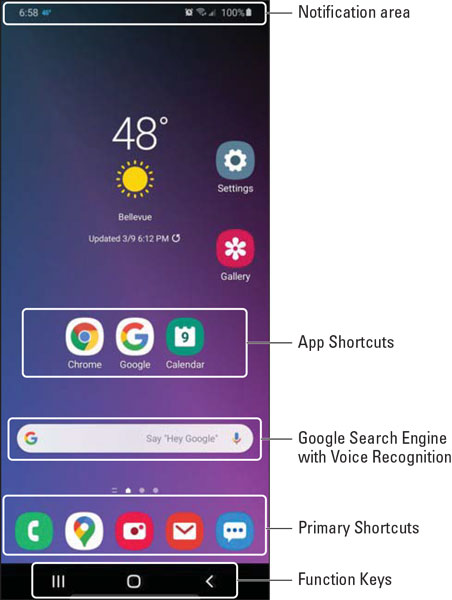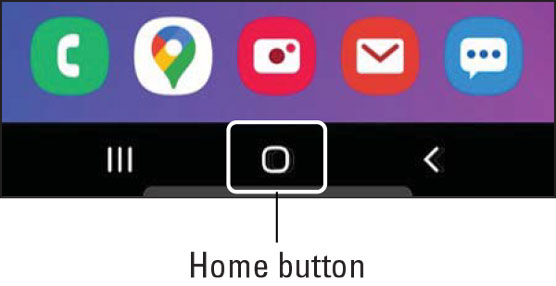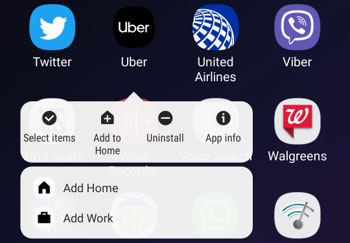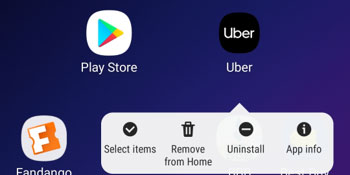 The Galaxy S20 phone panorama display of the extended Home screen.
The Galaxy S20 phone panorama display of the extended Home screen.At any given moment, you see only one screen at a time. You navigate among the screen by flicking to the right and left. The Home button will always bring you back to the Home screen.
The extended Home screen is where you can organize icons and other functions to best make the phone convenient for you. Out of the box, Samsung and your cellular carrier have worked together to create a starting point for you. Beyond that, though, you have lots of ways you can customize your Home screens for easy access to the things that are most important to you.
To start, check out the layout of the Home screen and how it relates to other areas of the phone. Knowing these areas is important for basic navigation.
The following figure shows a typical Home screen and highlights three important areas on the phone:
- The notification area: This part of the screen presents you with small icons that let you know if something important is up, like battery life or a coupon from McDonald’s.
- The primary shortcuts: These four icons remain stationary as you move across the Home screen. If you notice, these have been determined by Samsung and your cellular carrier to be the four most important applications on your phone and are on all the screens.
- The Function keys: These three keys control essential phone functions, regardless of what else is going on at the moment with the phone.
 Important areas on the Galaxy S20 phone and Home screen.
Important areas on the Galaxy S20 phone and Home screen.There are a series of dots just above the primary shortcuts on the extended Home screen. You may also notice that one of the dots isn’t just a dot — it’s a little house. That is the “home” Home screen. The brightest dot indicates where you are among the screens. You can navigate among screens by dragging the screen to the left or right. This moves you one screen at a time. You can also jump multiple screens by tapping on the dot that corresponds to the screen number you want to see or by dragging the dots to the screen you want to see. The following sections give you more detail on each area.
How to use the Galaxy S20 Home button
One of the important design features Samsung has implemented with the Galaxy phone is the “invisible” Home button. Some other smartphones have a physical button on the bottom of the front screen. To offer more screen real estate, the S20 makes it a software-based button on the bottom in the center of the function keys.The Home button may not look like much, but it is very important because it brings you back to the Home screen from wherever you are in an application. If you’re working on applications and feel like you’re helplessly lost, don’t worry. Press the Home button, close your eyes, click your heels together three times, and think to yourself, “There’s no place like home,” and you will be brought back to the Home screen.
 The Galaxy S20 Home button on the front.
The Galaxy S20 Home button on the front.You don’t really need to do all that other stuff after pressing the Home button. Just pressing the Home button does the trick.
How to add shortcuts to the galaxy Home screen
You have a lot of screen real estate where you can put icons of your favorite applications and widgets. (Widgets are small apps that take care of simple functions, like displaying time or the status of your battery.) You can add shortcuts to the apps and to these widgets to your Home screen by following these steps:- From the extended Home screen page where there is some space for the icon of an app, swipe your finger upward on the screen. This brings up a directory of all the apps you currently have on the phone. The number of apps and pages for their icons is practically unlimited.
- Press and hold the icon of the app you want to add. The icon under your finger will get a pop-up like the one shown in the following figure.
- Tap the Add to Home option. The icon now appears in a random spot on one of your home pages. If you like where the icon is, you’re all set. If you want to move it to another spot on your Home page, continue on to the next step.
- Press and hold the icon you want to move. Two things happen with the icon. First you get a pop-up that asks you if you want to uninstall the app and some other options. To move the icon, slide your finger on the screen to where you want it to live. When you’re happy with its location, lift your finger and it now has a new home.
 An Apps page.
An Apps page.Done.
How to take away shortcuts
Say that you find that you really don’t use that app as much as you thought you would, and you want to have less clutter on your Home page. No problem. Press and hold the icon. A pop-up like the one shown appears. The shortcut pop-up on the Home page.
The shortcut pop-up on the Home page.Simply tap the garbage can, and off it goes to its maker.
It’s gone from your Home page, but if you made a mistake, you can get it back easily enough. To re-create it, simply go back to the App Menu key and follow the process again. It’s still on your phone.





